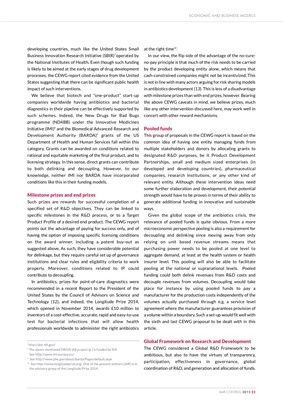
developing countries, much like the United States Small
Business Innovation Research Initiative (SBIR)7 operated by
the National Institutes of Health. Even though such funding
is likely to be aimed at the early stages of drug development
processes, the CEWG report cited evidence from the United
States suggesting that there can be significant public health
impact of such interventions.
We believe that biotech and "one-product" start-up
companies worldwide having antibiotics and bacterial
diagnostics in their pipeline can be effectively supported by
such schemes. Indeed, the New Drugs for Bad Bugs
programme (ND4BB) under the Innovative Medicines
Initiative (IMI)8 and the Biomedical Advanced Research and
Development Authority (BARDA)9 grants of the US
Department of Health and Human Services fall within this
category. Grants can be awarded on conditions related to
rational and equitable marketing of the final product, and to
licensing strategy. In this sense, direct grants can contribute
to both delinking and decoupling. However, to our
knowledge, neither IMI nor BARDA have incorporated
conditions like this in their funding models.
Milestone prizes and end prizes
Such prizes are rewards for successful completion of a
specified set of R&D objectives. They can be linked to
specific milestones in the R&D process, or to a Target
Product Profile of a desired end product. The CEWG report
points out the advantage of paying for success only, and of
having the option of imposing specific licensing conditions
on the award winner, including a patent buy-out as
suggested above. As such, they have considerable potential
for delinkage, but they require careful set up of governance
institutions and clear rules and eligibility criteria to work
properly. Moreover, conditions related to IP could
contribute to decoupling.
In antibiotics, prizes for point-of-care diagnostics were
recommended in a recent Report to the President of the
United States by the Council of Advisors on Science and
Technology (12), and indeed, the Longitude Prize 2014,
which opened in November 2014, awards £10 million to
inventors of a cost-effective, accurate, rapid and easy-to-use
test for bacterial infections that will allow health
professionals worldwide to administer the right antibiotics
at the right time
10
.
In our view, the flip side of the advantage of the no-cureno-pay
principle is that much of the risk needs to be carried
by the product developing entity alone, which means that
cash-constrained companies might not be incentivized. This
is not in line with many actors arguing for risk sharing models
in antibiotics development (13). This is less of a disadvantage
with milestone prizes than with end prizes, however. Bearing
the above CEWG caveats in mind, we believe prizes, much
like any other intervention discussed here, may work well in
concert with other reward mechanisms.
Pooled funds
This group of proposals in the CEWG report is based on the
common idea of having one entity managing funds from
multiple stakeholders and donors by allocating grants to
designated R&D purposes, be it Product Development
Partnerships, small and medium sized enterprises (in
developed and developing countries), pharmaceutical
companies, research institutions, or any other kind of
relevant entity. Although these intervention ideas need
some further elaboration and development, their potential
strength would have to be proven in terms of their ability to
generate additional funding in innovative and sustainable
ways.
Given the global scope of the antibiotics crisis, the
relevance of pooled funds is quite obvious. From a more
microeconomic perspective pooling is also a requirement for
decoupling and delinking since moving away from only
relying on unit based revenue streams means that
purchasing power needs to be pooled at one level to
aggregate demand, at least at the health system or health
insurer level. This pooling will also be able to facilitate
pooling at the national or supranational levels. Pooled
funding could both delink revenues from R&D costs and
decouple revenues from volumes. Decoupling would take
place for instance by using pooled funds to pay a
manufacturer for the production costs independently of the
volumes actually purchased through e.g. a service level
agreement where the manufacturer guarantees provision of
a volume within a boundary. Such a set-up would fit well with
the sixth and last CEWG proposal to be dealt with in this
article.
Global Framework on Research and Development
The CEWG considered a Global R&D Framework to be
ambitious, but also to have the virtues of transparency,
participation, effectiveness in governance, global
coordination of R&D, and generation and allocation of funds.
ECONOMIC AND BUSINESS MODELS
AMR CONTROL 2015 23
7 http://sbir.nih.gov/
8 The above mentioned DRIVE-AB project (p ) is funded by IMI.
See http://www.imi.europa.eu/.
9 See http://www.phe.gov/about/barda/pages/default.aspx
10 See http://www.longitudeprize.org/. One of the present authors (JAR) is in
the advisory group of the Longitude Prize 2014.